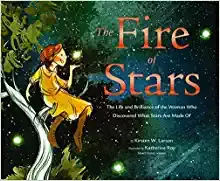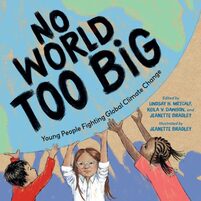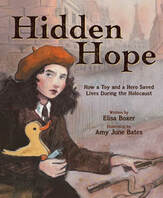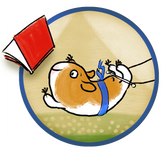Living for the Lightning Bolt - Kirsten W. Larson  My book with illustrator Katherine Roy, THE FIRE OF STARS (Chronicle Books), is a double read aloud, sharing the life story of astronomer Cecilia Payne, told alongside the process of star formation. The book parallels the kindling of Cecilia Payne's own curiosity and her scientific career with the process of a star's birth, from mere possibility in an expanse of space to an eventual, breathtaking explosion of light. Cecilia lived her scientific life in pursuit of the thrill of discovery versus fame or fortune. She first felt that thrill as a young girl, when she figured out all on her own why a flower was shaped like a bee (to trick the bees to mate with it and pick up pollen). For her, that feeling of understanding was electric and alluring enough to help her persevere through years of befuddlement as she searched for scientific breakthroughs. I felt such a kinship with Cecilia when I read this, as I feel exactly the same way about writing. I can labor for years in the dark on a single story idea. I try writing it different ways using various structures, voices, and points of view. And then, just when I’m about to throw up my hands in frustration, it all comes together in a lightning bolt of insight when I discover my draft. I live for the moment when a draft finally comes together, and I feel I’ve got it just right. And what I’ve learned from experience and from studying scientists like Cecilia is that you can’t force the break through. You will never know when it’s going to happen. You just have to stay present with the work even when you want to give up. And then, when you least expect it (in the shower, on a walk, or while doing dishes), it all comes together. Working Together Is Better - Lindsay H. Metcalf  Collaboration is my secret sauce for breakthroughs. This is true of both the poetry anthologies that I’ve created with Jeanette Bradley and Keila V. Dawson — first NO VOICE TOO SMALL: Fourteen Young Americans Making History (Charlesbridge, 2020), and now, as of March 14, the companion title, NO WORLD TOO BIG: Young People Fighting Global Climate Change. It’s also true of the activism both books showcase. Both of these books feature mini-biographies-in-verse of activists doing important work. While it's true that most movements are fronted by a “face,” no activist works alone, at least not for long. One of the key takeaways from NO WORLD TOO BIG is the importance of shifting mindsets in the climate-action space from “me to we,” moving from small-scale individual action to scaled-up collaboration, whether it be in schools, communities, or beyond. Greta Thunberg started her Fridays for Future climate strikes alone at the Swedish Parliament but was quickly joined by millions around the world. Leah Namugerwa helped hundreds celebrate their birthdays by planting “birthday trees” in Uganda. Students at the Green School in Bali worked together to convert their school buses to biodiesel fuel. And Nikita Shulga and Sofiia-Khrystyna Borysiuk persuaded hundreds of schools across Ukraine, starting with their own, to compost food waste. When we work together, we see the potential for real impact. I instinctively knew this to be true for activism. But it took me longer to learn that the same is true for writing—which happens to be my preferred method of activism. Our books are, of course, poetry anthologies, melding diverse voices of award-winning and bestselling poets. Each poet brings different strengths and experiences, which creates a powerful harmony of voices calling for climate action. But the books are also a collaboration between Jeanette, Keila, and I, the three anthology editors. The thing about working with two other writers who happen to be brilliant in different ways means that when one of us gets stuck, someone else probably has a way forward. This speeds up the revision process as all of us massage the text. (Besides poems, these books have a lot of sidebar and back matter text.) We form a built-in critique group. With Jeanette’s background in science and policy, Keila’s experience in education, and my time as a newspaper editor and reporter, that’s a pretty powerful combination. One of the main reasons we felt compelled to work together again after releasing NO VOICE TOO SMALL was to showcase the wide range of ways people around the world are tapping into their talents and tackling different aspects of climate change. We wanted to address any climate anxiety young people may be experiencing by encouraging them to counteract their anxiety by taking action. Beyond that, working with your peers is not only more effective, it’s helpful for keeping energy high when things get tough—in both activism and writing. Plus, working together is just more fun. On Hiding, Hope, and Safe Space to be Seen - Elisa Boxer  I put off writing this post until the last minute. With apologies to my colleagues, who had their sections done with plenty of time to spare, here I am on the eve of our deadline and my share of the Google doc is still blank. This hasn’t been typical procrastination. I’ve had it written in my mind for weeks. It’s personal. It’s vulnerable. And that’s why it has sat in my head rather than on the page. But I have a book coming out next month about a teenage French resistance fighter who used a hollowed-out toy duck to hide false identity papers from the Nazis during WWII. In addition to telling the story of this Holocaust hero, HIDDEN HOPE (Abrams, illustrated by Amy June Bates) highlights the importance of never having to hide the truth of who you are. It’s a message I want more than anything for young readers to internalize. And so, I will begin. Because, inspired by the heroism of my main character, I want to show people that their voices, their experiences, and their identities should never be hidden. I believe our books can be windows into aspects of who we are. And through those windows, readers can hopefully see themselves and know they’re not alone. According to Hitler’s plan, I’m not supposed to be here writing this. Growing up, I learned about the Nazis’ intention to build a “museum of an extinct race,” displaying Jewish artifacts like the torah scroll in our temple. Our particular scroll was rescued from a synagogue in Czechoslovakia, which the Nazis burned to the ground. Even as I felt a sense of intrinsic pride in being among a minority with a history of persecution and survival, there was a part of me that felt like I had to hide my Jewish identity. In third grade, a classmate who I thought was my friend took out a ruler and tried to measure my nose, because his parents told him “Jews have big noses.” Just out of college, I was excited to be out with a new group of friends who decided to test if I really was in fact Jewish by dropping a nickel on the ground to see if I’d pick it up. There were countless examples in between. In each case, no one who saw what was happening said anything. Often, I was accused of being too sensitive, unable to take a joke. I would sometimes feel so self-conscious that I wouldn’t speak up. It took me a long time to come out of hiding — to develop my Jewish voice — even when it didn’t feel safe. I’m hoping this book takes its place alongside others that are opening up wider conversations about anti-Semitism. I’m also hoping it encourages awareness about the importance of having a safe space to be the full truth of who we are, regardless of religion or experience or identity, and the importance of holding that space for others to do the same.  To learn more about Kristen Larson visit here. To learn more about Lindsay H. Metcalf visit here. To learn more about Elisa Boxer visit here. To purchase their books, please click on the cover photos in the post. All three authors are members of The Soaring ‘20s—High Flying Books for Kids and Teens.
0 Comments
 by Annie Romano Form submissions such as Query Manager have become the new normal for writers submitting to agents. Fading are the days of email queries (though some agents still accept them). At a glance, it seems like completing a submission form is straightforward: Fill in the blanks. Easy, right? But there are common missteps that might create a negative impression for agents before they even read your sample pages. What follows is a walk-through of the most encountered submission form features with notes on common errors or shaky habits. Avoiding these missteps will help your submission present as professional and polished. (Note: Since agents can customize their forms, only the most common fill-in-the-blank features are covered here. Also, agents have their own style of considering submissions. Some read the query letter first; others jump right into the sample pages. These are simply tips to help you ensure your submission shines.) WORD COUNT: Approximate word count is fine. If your word count is 97,256 words, 97,000 will suffice. This isn’t a make-or-break issue by any means; just something to be aware of. GENRE: This IS important. Writers sometimes try to fit a genre that agents don't accept into their inbox by choosing another category. For instance, I do not represent science fiction, so there’s no “Science Fiction” option in my genre dropdown menu, but I’ll often get submissions for this genre submitted under the “General Fiction” category. Once I read that query/pages and it becomes clear the manuscript is sci-fi, I’m not going to accept it. And it’s not because it’s not well-written; it’s because I don’t represent sci-fi. It’s simply not in my wheelhouse, and writers should want their work represented by someone who knows the market for their genre and is familiar with what editors are seeking for that particular category. QUERY LETTER: Yes, it’s a form, and yes, you clicked this specific agent’s link and typed in your name in the spaces above, but the query letter should still be a letter. In other words, it should be addressed to someone. (Some agents might not care about this detail, but to me it shows you’re taking care with your submission.) Include the agent's name: Dear “X,” and be sure it’s the correct name! Even with a form link, I still get query letters addressed to other agents. In the body of your query letter, provide your pitch/hook, brief book/project description, and any biographical information that is relevant to your writing (some agents have a separate section for your bio). If you don’t have any specific writing credentials or publications to include here, consider mentioning the inspiration for your story or why you're querying that particular agent (i.e., because they’re seeking “x” genre or because they represent books similar in tone to yours). A simple statement indicating you’ve researched an agent’s interests goes a long way in helping your query stand out. SYNOPSIS: A synopsis should be approximately one page in length (single-spaced) and should give an overview of the storyline. It should include spoilers. If I receive a fiction synopsis that’s slightly longer than a page, that doesn’t bother me. But if it’s clear the writer doesn’t know how to write a synopsis (i.e., the synopsis is only a few sentences, or it's twelve pages long with character sketches and a chapter-by-chapter breakdown), that leads me to question the writer’s preparedness. Writing a synopsis can be challenging, which is why a solid effort is impressive. If you’re not sure how to write a novel synopsis, do some research and educate yourself on it before submitting. For picture book writers, one brief paragraph should suffice (though I do not represent PBs, so check individual agent websites for their specific guidelines). If you're submitting an adult nonfiction book proposal, chapter summaries/outlines are acceptable, but again, be sure to check individual agent websites for submission preferences/guidelines. SAMPLE: Regardless of whether the agent has included an upload link or asks that you paste in your sample pages, be sure to include only the page count the agent requests (though most agents don’t mind if you round up or down to the closes section/chapter break). Do not paste 20 pages if the agent asks for five. It shows a lack of respect for the agent’s guidelines. Also, sample pages should begin with the opening pages of your manuscript (or full picture book manuscript) unless otherwise indicated. PITCH: Yes, you probably included this in your query letter, and the form can often feel redundant, but consider this an opportunity to recapture the agent’s attention. Make sure it’s compelling and catchy. Some agents do not care for hypothetical questions as a pitch, so consider rephrasing if your pitch is formatted as a question. Also, read the prompt carefully. If the agent asks for a one-sentence pitch, give one sentence. If they ask for a paragraph, be sure that’s what you include. SIMILAR TITLES: Don’t leave this blank unless it’s optional. If you included comp titles in your letter, simply retype the comp titles in this section. Some authors do not include them in their query, so this question is an agent’s way of ensuring the writer provides them. This prompt shows the agent that the writer has considered the market and where their manuscript sits within it. Writing something like, “nothing compares to my novel,” “I couldn’t think of any,” or “my idea is completely original” isn’t the best way to approach this section. The “similar titles” question isn’t insinuating that your manuscript isn’t unique; it shows that you understand there are categories and genres in publishing and that you are informed regarding where your book would sit on the shelves. TARGET AUDIENCE: This is another way for the agent to gauge your understanding of your manuscript’s appeal. If you’ve written a horror novel dripping with violent scenes and gore, stating it will appeal to children might raise some eyebrows. Of course, that’s an extreme example, but take care to give this prompt some careful thought. Stating your rom-com will appeal to readers of Emily Henry or those who enjoy Nora Ephron films is a solid, sensible response. Stating that your book is “perfect for everyone who loves to read” indicates an unrealistic expectation of your book's appeal. Adhering to an agent’s guidelines and thoughtfully responding to all the sections of their query form will go a long way in showing your effort and respect for the submission process and will help your query stand out from the many submissions agents receive each week. You’ve put in the time and effort to submit a polished, professional query, and now you wait. When you receive a response, hopefully it’s a request. “I’d love to see the full!” is the message writers dream of reading. When that isn’t the case, a form letter is the usual response. Below is a note about the dreaded form rejection. It won’t erase the sting they deliver, but hopefully it will offer some perspective. FORM RESPONSES: We writers tend to be a diligent, detail-oriented bunch, so form letters often send us over the edge. You’ve poured your heart into your manuscript, agonized over your query letter, read dozens of books to find the perfect comp titles, and then…Bam! You receive a form rejection. The nerve! As a writer myself, I understand the frustration with form responses. I receive them, too, and I don’t like them. But as an agent? I understand they’re a necessary evil. When I started agenting, I was determined to send personalized feedback to all who queried me. I soon found myself drowning under the volume of submissions in my inbox and falling behind at an exorbitant rate because I wanted to include specific feedback in each response. I wanted to prove I had considered every query. It wasn’t long before I had to face facts: if I wanted to reply to everyone (and not have a “no response means no” policy), I’d have to incorporate a form letter for passes. It wasn’t an easy decision, but it was necessary. While this is my opinion, other agents have expressed a similar sentiment: It gives them no pleasure to send form rejections, but it’s the only way to keep up with the volume of queries received while still attending to their other agenting responsibilities. So yes, form rejections are frustrating, but they’re a result of time constraints, not a measure of an agent’s respect for your efforts or talent. Please remember that. In summary, making it to publication is extremely difficult, but putting your best foot forward when completing an agent’s submission form will help you get there. When you send a submission, celebrate! You’ve written a book! Don’t forget to embrace that accomplishment. Cheers to you and your writing!  Annie Romano is a literary associate with Olswanger Literary. She represents adult fiction and select nonfiction projects. She is also a published children’s book author and one of the founders of 24 Carrot Writing. You can learn more about her at www.anniecroninromano.com.  Art by Janine Nel. Art by Janine Nel. ~by Amanda Smith A couple of months ago, I was prattling my mental to-do list aloud while my husband patiently listened. “… and I still have to write down my monthly goals before our 24 Carrot meeting tomorrow,” I said, running out of breath, and steam. And time. His eyes glinted mischievously. “Just copy last October’s goals,” he said. Wrapped up in my busyness, I retorted, “If I could just copy last year’s goals, that means our method doesn’t work very well, does it?” But wait? Does it? His silly suggestion intrigued me. 24 Carrot Writing celebrated its eighth birthday this year. For eight years (more actually, because we were an accountability group before we were a blog) I’ve religiously set monthly goals, checked them off, and reported back to my partners. Our whole premise is rooted in the idea of setting monthly goals and rewarding ourselves for reaching those goals. But the elephant in the room asks: Does it actually work? I always check my yearly goals around this time of the year to see where I hit the mark, where I missed, and where, perhaps the road turned in a different direction. We also encourage our readers to check those goals mid-year with our June Years Eve blogs, making sure we are on track. But never have I ever checked a random month from the previous year to see how it lined up with my current journey. In the day-to-day work of writing, does setting monthly goals actually move me markedly forward? Color me curious! So, with a hint of trepidation, I flipped back to October 2021 in my beloved bullet journal to reread my goals.
What about other 24 Carrot writers? I asked them to peek back at their goals. Kelly:
In the past Kristi had a running list of tasks she’d cross off upon completion, but in January 2022 she joined our accountability group and took up monthly goal setting. One of her January goals was to revise a picture book. Her goal for this manuscript was to send it to Gnome Road publishing when their submission window opened in March. ALPACHAS MAKE TERRIBLE LIBRARIANS will hit the shelves in 2024, published by Gnome Road!
The trend is consistent: projects that were started are now complete, rewrites and revisions occurred, picture books went from concept to query (with all the appropriate in-between steps!), some projects carried over from month to month (oops), but eventually, they get done (or end up in the “darlings file”). Beautiful, inspiring forward motion. By Jove! It works! Would we have done some of these things, even if we hadn’t set them as monthly goals? Likely. But would we have done all of them in a timely manner? Definitely not. To be certain, the smaller things, such as those poems, would have fallen off my radar, and I would have missed out on the joy of this anthology to come. When our kids sometimes feel overwhelmed by the size of a task, my husband would ask: “How do you eat an elephant?” One bite at a time. In the elephantine cycle of writing, revising, critiquing, polishing, querying, waiting, signing, selling, marketing, promoting, doing-it-all-over-again, monthly goals are manageable bites. So this January, yes, dream big and set those yearly goals! But then commit to bite-sized monthly goals, break them up in daily tasks, and keep moving forward. And every once in a while, peek back and see your progress – the biggest, sweetest, brightest carrot of all! To learn more about my bullet journal, and how you can also keep track of things like monthly and yearly goals, check out this blog. |
Peruse blogs for advice and tips from KidLit creatives.
Categories
All
Archives
April 2024
Click to set custom HTML
Click on the RSS Feed button above to receive notifications of new posts on this blog.
|



 RSS Feed
RSS Feed